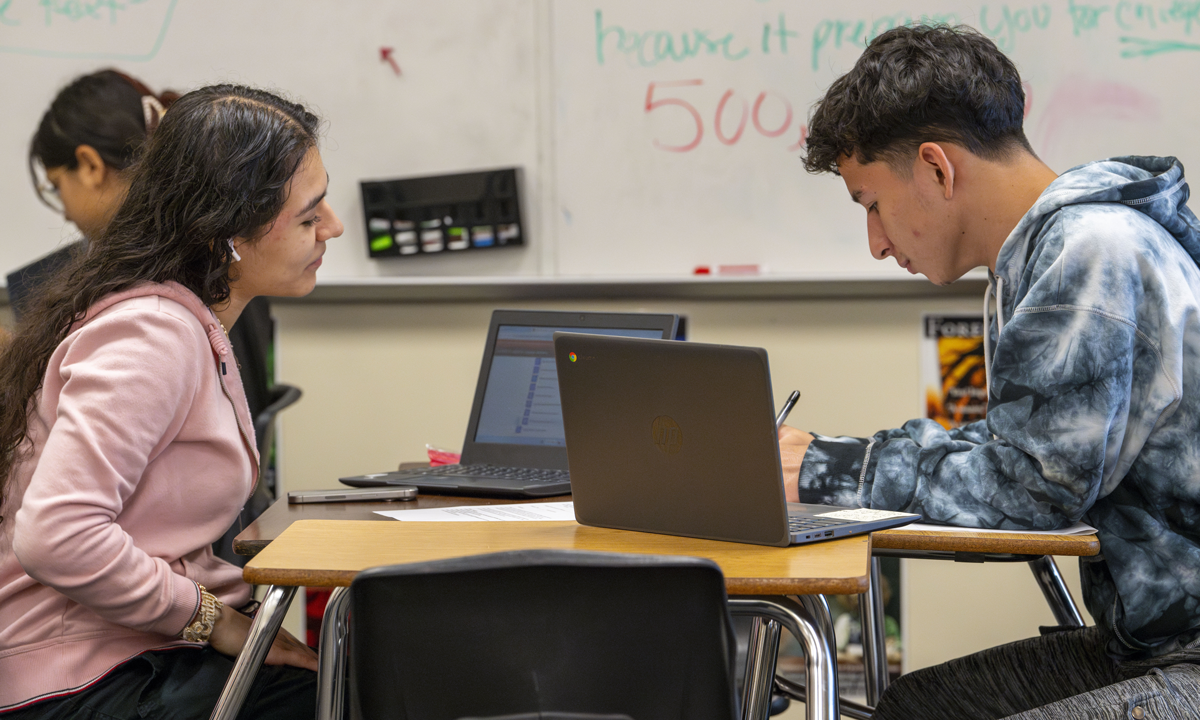The Road to Educational Equity: Can Ed Tech Solve the Digital Divide?
Prakash: Ed tech is not a short-term fix or an optional add-on, but rather a core element of a broader equity agenda prioritizing student outcomes.

Get stories like this delivered straight to your inbox. Sign up for The 74 Newsletter
In a nation where ZIP codes often determine opportunity, the promise of educational equity remains out of reach for millions of students. Despite years of reform, the link between a child’s environment and their academic outcomes still remains.
Today, as schools integrate digital tools into everyday learning, a new dimension of inequality has come into focus: access to technology. While some students benefit from personalized platforms and high-speed connectivity, others are still left behind, struggling to participate in a system that increasingly assumes digital access. The debate is no longer whether ed tech can improve education, but whether it will reach those who require it the most.
The integration of technology into classrooms has the potential to improve learning, but only if access is universal. In reality, disparities in broadband connectivity, device availability, and digital literacy continue, especially in rural and low-income regions.
A 2024 report by the Pew Charitable Trusts indicates that 43% of adults earning less than $30,000 annually lack broadband access, and nearly half of households making under $50,000 struggle to afford internet services.
This leads to a “homework gap” that disproportionately impacts students in excluded communities, limiting their ability to complete assignments and engage with digital learning resources.
Beyond infrastructure, the challenge extends to technology deployment. Schools with more resources can invest in training educators, curating high-quality digital content, and supporting students with tailored interventions. In contrast, under-resourced schools may lack the technical assistance and instructional direction required for effective ed tech integration. Without thoughtful implementation, technology risks becoming a superficial fix rather than a meaningful equalizer.
To bridge the gap, tech access should be treated as a foundational right, not a privilege. That means investing in affordable internet for all households, making sure every student has access to a reliable device, and providing the support systems that make digital learning meaningful and accessible.
Ed tech, when designed and deployed with equity in mind, can be an effective tool to close learning gaps. AI-powered and gamified learning platforms, for example, offer the ability to personalize content to meet students where they are, regardless of age, ability, or background.
Adaptive platforms, for instance, are able to recognise when a student is behind and make real-time material adjustments. Through milestones and rewards, gamified modules can keep students motivated. This is especially helpful for students who might otherwise lose interest in a strict, one-size-fits-all approach. These features can have a particularly significant effect on classrooms with a variety of learning demands but a small number of teachers.
Too often, though, innovative learning technologies are piloted in affluent districts with the budget and infrastructure to support them, while the students who could benefit most remain out of reach. Without targeted strategies to expand access and usage, ed tech risks strengthening the very disparities it aims to address.
True equity means creating educational technology that represents the diversity of the learners themselves. This includes considering various cognitive styles, linguistic backgrounds, and cultural situations. Platforms should offer multilingual support, dyslexia-friendly fonts, sensory-sensitive modes for neurodiverse kids, and culturally relevant material. Without these design considerations, ed tech may inadvertently exclude the very students it aims to uplift, even when devices and internet access are available.
The answer lies not just in the tools themselves, but also in how and where they are deployed. Equity-focused implementation requires a commitment to both access and impact –- ensuring students can use the technology, and that the technology truly supports their learning journey.
This is not a challenge educators can tackle alone. It requires coordinated action from policymakers, district leaders, nonprofit partners, and the tech community itself.
Public investment should prioritize infrastructure development in under-served areas, such as expanding broadband coverage and subsidizing device distribution. Equally important is funding for professional development, helping teachers integrate digital tools into their pedagogy in ways that are culturally responsive, developmentally appropriate, and aligned with academic goals.
At the policy level, educational equity must be embedded into procurement decisions, funding formulas, and accountability frameworks. Leaders must ask not just whether technology is available in schools, but whether it is making a measurable difference for students who have historically been left behind.
Collaboration across sectors is critical. Nonprofits can help support communities in navigating the digital learning landscape. Tech providers can design solutions with accessibility and inclusion built in from the start. And local governments can act as conveners — aligning resources, reducing duplication, and ensuring families are supported beyond the school day.
There is no silver bullet to educational inequity, but there is momentum. Across the country, districts are experimenting with community Wi-Fi programs, public-private partnerships, and learning models that prioritize flexibility and student engagement. These efforts prove that with the right intentions, innovation and inclusion can go hand in hand.
What’s needed now is sustained commitment. We should resist the temptation to view ed tech as a short-term fix or an optional add-on. Instead, it must be approached as a core element of a broader equity agenda, one that prioritizes student outcomes, not just new tools.
Ed tech holds enormous promise, but only if we build systems that ensure its promise reaches every student. That starts with recognizing that the digital divide is not just a tech problem, it’s an equity problem. And equity is something we must design for from the beginning.
Get stories like these delivered straight to your inbox. Sign up for The 74 Newsletter

;)